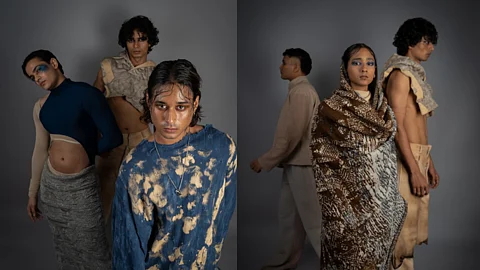
- HOMEGROWN WORLD
- #HGCREATORS
- #HGEXPLORE
- #HGVOICES
- #HGSHOP
- CAREERS
- ABOUT US
- CONTACT US

To say that the Partition was a tragedy is an understatement that barely does justice to the millions of people whose lives were torn apart by the specter of imperialism. For countless Indians, it serves as a painful memory of the friends and family they lost as well as the homes that they were forced to flee.
It is this profound sense of loss that designer Iara and their team attempted to channel with their collection — 'Mohajir'. We spoke to Iara, who let us in on how they conceptualized the garments and weaved in themes of displacement and grief while paying tribute to those who were and continue to be affected by the Partition.
Tell us a little about this project.
The narrative of being internally displaced within one's own mind and mourning personal losses, as exemplified by the countless narratives, represents a story that is both familiar and overlooked.
Mohajir, delves into the successive generations that endured the tragic disintegration that took place in 1947 and the partition of Punjab, drawing intriguing parallels between the concept of grief and individual generational experiences.
My collection sheds light on the tales of partition through the encounters of five generations of a family, each of which correlates to one of the five stages of grief.
Describe your creative process and the purpose with which you create.
I often see my garments as a canvas to narrate the countless stories unheard, lost in time. I use fashion as a medium of self-expression and often do not limit my garments to being just something that's worn. I want them to be things that are talked about, to break the barriers of conventional story telling and bring in a fresh new perspective. Deconstruction is a constant theme surrounding my garments as it challenges the traditional methods of garment construction and puts forward a brand-new perspective for individuals to work with.
What are some of your biggest inspirations over the years of your artistic career?
For this particular collection, I have drawn inspiration from two of the most iconic fashion designers known for their unique sense of style — YOHJI YAMAMOTO and PROFESSOR.E. Their distinct methods of garment construction and over the edge silhouettes have contributed to being a significant part of my collection.
History has also played an important role in my upbringing and to a certain extent has shaped my creative process. I often find myself going back in time to draw inspiration as it has so much to offer and learn from.
What are some things you learned while putting this project together?
There were many such things that i came across but the most significant one would the beautiful history of phulkari and how a mother would pour her soul into making a piece of phulkari for it to be a significant part of her daughters wedding trousseau. She would start the process as soon as a daughter was born and would continue it till her wedding preparations. I have tried to portray it through a fresh new perspective in my final ensemble using computerized knitting and by blending in abstract art forms along with a non-traditional color palette.
Another one that i would like to mention would be the poem written by the famous poet, Faiz Ahmad Faiz, 'Subh -e- Azadi', which beautifully narrated the aftermath of the Partition and documents in some detail, his personal experiences, and how it fails to justify the losses we had to bear. This poem has been the foundation for my design collection and was my starting point.
Who are some artists who are currently on your radar?
Kaavish, a Pakistani Indie band known for their beautiful classical music and Arsalan, a digital artist known for their unique representation of South Asian culture.
Credits:
Garments, Styling, and Art Direction - @whos.iara
Photography & Editing - @fr4sr
In Frame - @mihirr_gg @sharanshettyyyy, @smruthi__ @kshitijrhtkr, & @param.suru
Hair & Makeup - @tisshmaa & @farzeen._.balsara
You can follow Iara here.
